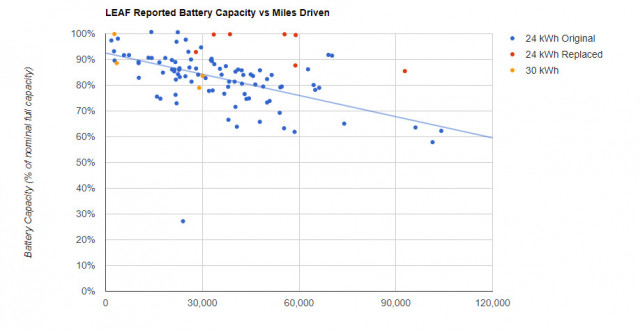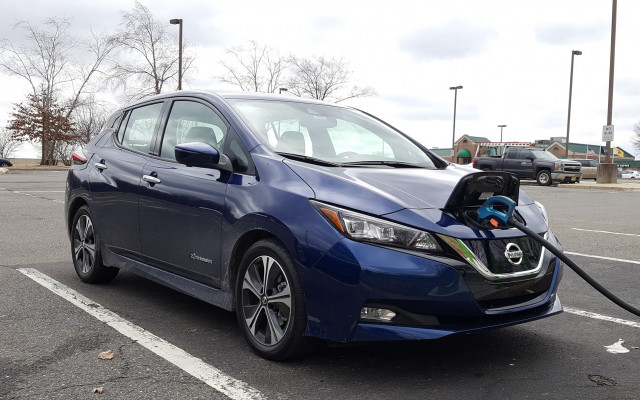
2018 Nissan Leaf with EVgo fast charger at NJ Turnpike Molly Pitcher travel plaza, Feb 2018
As Tesla has shown, not all fast charging is created equal. Now owners of the new 2018 Nissan Leaf are complaining that that the car’s “fast” charging is not always as fast as advertised.
Owners have found that the car’s electronic management software dials back charging speeds with each successive fast charge on any given trip.
Nissan says this behavior is a safeguard designed to protect the battery from overheating, which could otherwise shorten its lifespan and reduce the car’s range over time.
Still, owners suggest the behavior makes the new Leaf much less useful on long trips, when recharging starts to take hours instead of minutes as you get closer to your destination.
So many drivers are frustrated by the situation that the issue has taken on its own Twitter hashtag: #rapidgate.
Green Car Reports reached out to Nissan North America to ask for comment on this issue, but had not heard back at the time this article was published. We will update the story if we receive a response.
Nissan issued a response to Transport Evolved, however, saying: “The 2018 Nissan Leaf has charging safeguards to protect the battery during repeated fast charging sessions in a short period of time. While the safeguards may increase charging times after multiple fast charging sessions, they are important to maintaining battery life over an extended time period.”
In other words, it’s a feature, not a bug.

Plug-in America chart showing Leaf battery degradation
Battery life has been a problem for Leafs from the beginning.
Many owners, especially in the U.S. desert Southwest reported that their cars were no longer charging fully after as little as a year. Plug-in America has gathered data showing how many early Leaf batteries experienced premature degradation.
The problem stems from Nissan’s decision not to use a liquid-cooling system on either Leaf’s battery. Instead, it is air-cooled, much like an old Volkswagen.When the battery can’t dissipate heat fast enough when charging, its capacity can start to degrade.
Rapid charging heats the battery more than does driving or ordinary 240-volt charging. On a long trip, driving between fast-charge locations doesn’t give the battery time to cool sufficiently between successive fast charges.
2011 Nissan Leaf at 96,000 miles, photo by owner Rick SantAngelo
Enlarge Photo
Nissan covers degraded batteries, like the one in the original Leaf whose gauges are shown above, under warranty, but obviously wants to minimize its exposure–and that of owners–to paying for expensive replacement batteries.
So, it limits the speed of fast charges–essentially turning down the burner on the battery.
As in the original Leaf, Nissan uses a separate CHAdeMO connector for DC fast charging. CHAdeMO chargers in theory should be capable of providing up to 200 kw, though few stations seem to provide that much power.
READ ALSO: Nissan Leaf Battery capacity loss: Covered by warranty now
On Nissan Leaf forums, and in an EV “race” in Britain, drivers say that after the first fast charge, their charge rate drops to as little as 24 or 25 kW, which can take four to five hours to fully charge a new 40-kwh Leaf battery pack. At that rate, even with the car’s nominal 150-mile range, it could take 14 hours, rather than 9 or so, to make a 500-mile trip.
As our former correspondent Nikki Gordon-Bloomfield points out, that could be especially frustrating if you’re traveling with restless children.
If slowing down the fast-charge rate keeps more owners from having to pay for expensive battery replacements, we’ll accept Nissan’s argument that it’s a feature rather than a bug.
But if you’re looking for an EV that you plan to take on long trips, it’s worth keeping in mind that fast charges may get slower over those trips.

